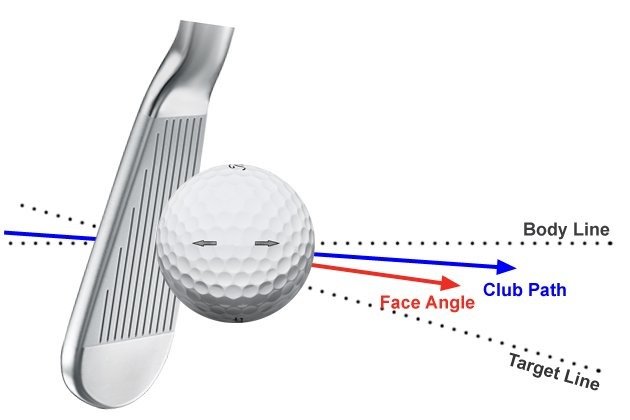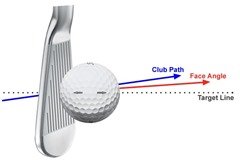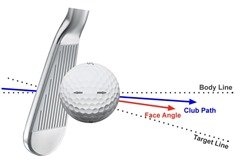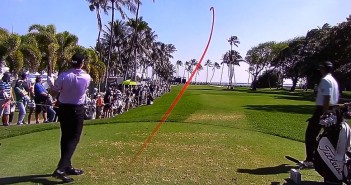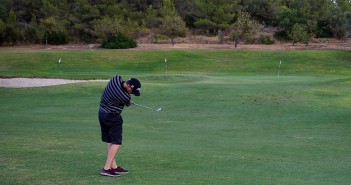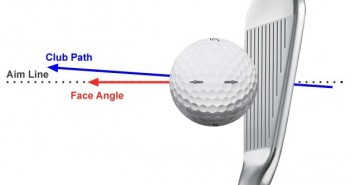One of our students (hi Mori!) sent in this question, asking us to write an article about it. We hear ya Mori, you wanna get all Lee Trevino up on their ass!
The “Power Fade” is a fascinating subject; not only is it a great shot to have in your golfing arsenal, but it’s a shot that isn’t well understood, and there’s a lot of nonsense written about it.
In order to explain the mechanics of this shot, we’ll have to delve into some of the fundamental concepts of ball striking mechanics.
Understanding these concepts will help you learn to shape your shots, to control the golf ball much more effectively. It will also help you to diagnose your swing flaws and quickly correct them.
Once you have read and digested the information presented here, you will be armed with the knowledge you need to play almost any shot. It will increase your “golfing IQ”, making you a better, more creative golfer.
In this article, we’re going to discuss what a Power fade is, how to play it, and exactly how and why it works.
As always, apologies to the lefties out there, but for simplicity we’ll describe movements for the right-handed golfer.
What is a Power Fade?
A Power Fade is a left-to-right curving ball that will come out low and hot, flying a long way through the air and then rolling a long way.
The Power Fade is a great shot for long dogleg-right tee shots, where you can’t carry the corner but you want to give yourself a good look at the green.
It can also be used effectively from the fairway, keeping the ball low, under the wind, and running it up through the neck of the green towards a back-right pin.
The Power Fade is not a slice!
A slice is a weak shot, caused by moving your body in an inefficient manner. A slicer will typically use his upper body too much, heaving his shoulders over the top, becoming disconnected from his core, and throwing the club out and away, losing the small amount of lag he managed to create well before impact, getting very steep and generating a huge amount of spin.
A Power Fade has two main characteristics: it’s a fade, and it’s powerful (duh!) – but how can we have both? Let’s find out…
The Fade
This difference between path and face causes the spin axis of the ball to tilt to the right, creating lift that pushes the ball right during its flight, curving it.
A normal fade, where the ball starts left and then curves back to the target, requires the club face to point slightly left of the target line (a closed club face), and a club path that is slightly more to the left (out to in).
The face starts the ball, the path curves it, as a general rule.
A normal fade will have more loft and more spin than a straight shot.
The slightly open face will increase the dynamic loft, and the slight “out to in” path will increase the angle of attack. The increased difference between dynamic loft and attack angle gives more spin loft, and so more spin.
The efficiency of impact (“smash factor”) will be reduced, resulting in less ball speed. This is because impact is directed away from the centre of mass of the golf ball, both in the vertical plane (more loft) and in the horizontal plane (open face). Also, more energy is used in the creation of spin, rather than pure ball speed.
The ball will fly higher (more dynamic loft), possibly carry a little further (more spin means more lift, but less ball speed), curve right in the air (tilted spin axis), land more steeply and stop quicker after landing (more spin).
So How Do We Get More Power?
More power, in this context, means a more efficient transfer of energy from the club to the ball, turning club head speed into golf ball speed, and thus distance. This ball striking efficiency is often referred to as “smash factor”, or “compression”.
”Compression” is a good word, if slightly misleading. It’s good because it describes how an efficient strike will compress, or squash, the ball against the club face during impact. The ball will then “bounce” off the club face, causing the ball to travel much faster than the club head. This “bounce” is known as the coefficient of restitution (COR) of the golf ball.
It is, however, a little misleading, because compressing the ball too much is a bad thing, reducing the COR and thus the efficiency of the strike. This is why you need a golf ball that matches your club head speed – a powerful swing needs a firmer, less “squishy”, golf ball.
Compression is what gives you that silky smooth feeling when you strike the ball well.
We’ve already described how a fade is less efficient than a straight shot, so how do we inject more speed to turn the fade into a Power Fade?
We can strike the ball more efficiently in a number of ways.
First, strike the ball out of the centre of the club face, the sweet spot. So we need an accurate, consistent swing with minimal manipulation.
Second, reduce the dynamic loft. Use a longer club and create forward shaft lean (hands ahead of the ball) at impact.
Third, minimise spin by reducing spin loft. To achieve this we need to create a shallow angle of attack.
Finally, although we need to spin the ball in order to fade it, to tilt its axis, this should be minimised.
And, of course, we need to make the most of all this efficiency by generating plenty of club head speed.
In summary, the Power Fade needs the following:
- Club path left of face angle.
- Good clean strike.
- Forward shaft lean.
- Shallow attack angle.
Tilted axis + high club head speed + efficient strike + low spin + low loft = Power Fade.
How to Play a Power Fade
A “draw swing”, attacking the ball from inside the target line, requires a flatter swing plane, and thus a shallower attack angle.
So, to play this shot we need a draw swing (in to out), but we still need the club face pointing to the right of the club path at impact – see Figure 2.
The ball will start right of your body (aim) line, and then curve further right – this is the hallmark of the Power Fade.
There are a number of ways to keep the club face open through impact. You could “hold the face off” with your hands, using various techniques, or weaken your grip.
But we need to be very careful with such manipulations.
A highly skilled player can “hold off” the face, but it’s difficult to do this accurately and consistently.
And messing around with your grip is horrible – of all the elements in your golf swing, the grip is the most precious. It’s your only link with the club, it transfers energy, it provides your control, it provides you with feedback throughout the swing, it is the source of your “feel”.
Mess with your grip, and you could struggle to find your swing again for the rest of the round.
For a normal fade, the way that we recommend you keep the face open through impact is to cup (extend) your left wrist very slightly at the top of the backswing.
This will open the club face slightly at the top, and when you then make your normal swing it will take you a fraction longer to close the face, and it will still be slightly open at impact – relative to the club path.
If you grip the club just a little more firmly than normal, this will also slow down the natural closing of the club face by slightly restricting your hand action in the release.
If you also move the golf ball just a little forwards in your stance, just 1-2” (2.5-5cm), then the club will be moving back inside at impact and you’ll have the perfect fade.
Cupping your wrist at the top, however, will steepen the downswing plane a little. That’s great for a fade, but not what we want for the Power Fade – we want a more shallow plane. Using this method, we’d have to work too hard to drop the club inside and attack the ball from the inside.
For the Power Fade, the best way to “hold off” the club face is to cup (extend) your right wrist a little less than normal coming in to the release (see Golf Swing Drill 504e – Downswing: The Right Hand Release Movement – the Spider-Man Drill – do this less).
This will mean that the club face is more open at the beginning of the release, and you won’t have time to shut the face before impact.
Again, grip the club just a little more firmly than normal to restrict your hand action in the release.
So, the technique for the Power Fade is:
- Use a low-lofted club – a long iron, fairway wood or driver.
- Align your body well left of the target – see Figure 2.
- Play the ball in the normal position for a straight shot.
- Grip the club just a little more firmly than usual.
- Make a “draw swing” – a slightly flatter swing than usual, aggressively attacking the ball from the inside.
- Cup your right wrist a little less than normal coming in to the release.
- Make sure that your hands lead the club through impact.
- Hold off the release a little in the follow-through, keeping the club face from turning over, and making more of a “punchy” swing.
If you’re playing a Power Fade with the driver, you’ll need to use the Power and Accuracy setup rather than the Maximum Distance setup.
Warning: these instructions assume that you normally hit the ball straight with a low- to mid-trajectory. If you struggle with a slice or a hook, then get outa here, work on your swing using the Swing like a Champion system, and come back when you’re ready.
This shot will take a little practice on the range to get right, but when you do it’s a fantastic tool to have out on the course.
Many of the world’s best golfers rely on this shot to keep them on the short stuff a long way out, and it holds up well under pressure.
The main risk with this shot is that if you lose your posture, you don’t keep your hips back, and you get “stuck” in the downswing, then your hands will instinctively work to slam the club face shut. You’ll end up with the infamous “double cross” and the ball will hook left of left.
But, if you make a reasonably good swing, this shot is very reliable.
A Note on Ball Position and Stance
For both the fade and the Power Fade, ball position at setup is relative to your stance.
You should not open your stance for either shot.
For the Power Fade, you should address the ball as you would for a standard straight shot. Swinging more from the inside and striking the ball with an open club face will create a low push-fade – the ball will start right and curve further right – see Figure 2.
You should aim your whole body left to cater for this – you’re not opening your stance, your stance is square relative to your aim line.
It just so happens that your aim line is left of the target line.
The golf ball should be positioned as normal relative to your stance.
The ball doesn’t know where the target is, from its perspective you’re hitting a push-fade.
For a normal fade, you should aim your whole body at the target, and move the ball slightly forwards in your stance.
This will put the ball slightly after your normal “straight hit” impact position in the swing arc, though you will still strike the ball before the bottom of the swing arc (your divot).
Thus, the club path will be moving slightly back in from the square position, and from outside the golf ball – see Figure 1.
This, combined with a club face that is open relative to the club path but closed relative to the target line, will start the ball left and curve it back towards the target.
Once again, the ball doesn’t know where the target is. For this shot, you’re hitting a high pull-fade.
The only time that you should open your stance, relative to your aim line, is when you deliberately want to slice the ball – for example when you’re in trouble and you want to work the ball hard around a tree.
Because this shot is deliberate, we won’t call it a slice, we’ll be generous and call it an exaggerated pull-fade.
You open your stance in order to promote an out to in swing path – this is highly inefficient but it will create the desired sweeping curve of the ball.
When you hear a pundit describing how a pro’s stance is open on the tee, they are mistaken.
The golfer is aiming their whole body left, knowing that the impact dynamics will send the ball right, towards the target – just like Lee Trevino did.
Happy fairways!

» The Mechanics of Golf Ball Flight.

